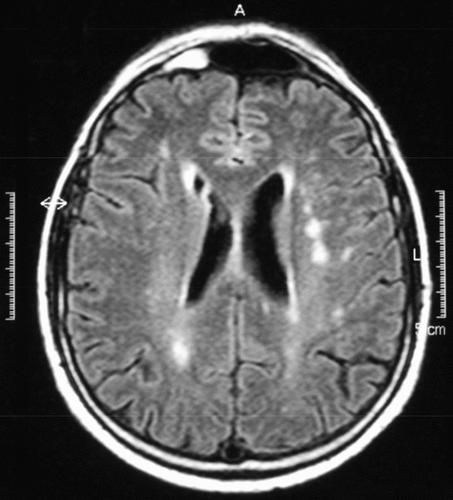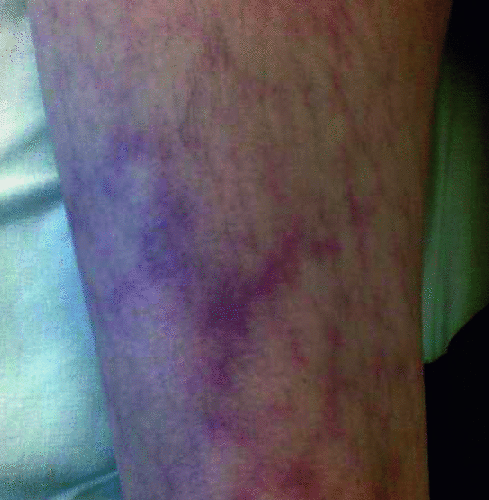A Suicide Attempt in a Context of Bipolar Symptoms Leading to a Diagnosis of Sneddon Syndrome
To the Editor: Sneddon syndrome affects neurological and dermatological vascularization. In this case, we reported a patient who stabbed himself with a knife and presented with mood disorders with incongruent psychotic features. Psychiatric symptoms are sometimes features for the onset of neurological conditions.
Sneddon syndrome was initially described as the association of ischemic strokes and generalized livedo.1,2 It is an uncommon immune syndrome (1/1,000,000/year), which affects the vascularization of dermatologic and neurologic systems. Bolayir et al.3 in an analysis of 10 patients diagnosed with a Sneddon syndrome, found that 30% fulfilled DSM-IV diagnostic criteria for depression. Our patient presented with a major depressive disorder, with mood-congruent psychotic symptoms.
Case Report
In 2008, a 70-year-old man was admitted in the Department of Psychiatry in Strasbourg after a suicide attempt; he had tried to stab himself with a knife. Psychotic features associated with depression were characterized by thoughts of worthlessness, delusional guilt, feelings of helplessness, and hopelessness. Depressive symptoms alternated within a few hours with hypomania, which manifested as mild euphoria associated with pressured speech and psychomotor agitation. His blood pressure was 170/100 mmHg. The patient was disoriented in time and space, without identifiable focal neurological symptoms.
The patient had no personal or familial history of previous psychiatric disorder, but past record of hypertension, ischemic heart disease with angioplasty (in 2002), and aortic valve replacement (2007).
Oral olanzapine treatment was started at a dosage of 7.5 mg per day. The MR scan done the next day showed multiple white-matter T2 hyperintensities, some of which were recent, according to the diffusion-weighted images. Psychiatric symptoms regressed rapidly. Two weeks later, the patient presented with an acute manic agitation associated with mystical delusions and visual hallucinations concomitant to a bout of hypertension (210/110 mmHg). Increasing the antipsychotic dosage had no effect. The electroencephalogram (EEG) showed no sign of epilepsy. The MRI scan excluded a reversible posterior leukoencephalopathy syndrome, but showed new T2 hyperintensities in the periventricular white matter with increased diffusion-weighted signal, supporting recent ischemic damage. The angioMR provided no evidence of an arterial clot (Figure 1). Two days later, the clinical picture was completed by a livedo reticularis on the back and the buttocks (Figure 2). Antiphospholipid antibodies were slightly increased (× 1.5 increase in IgM anti-beta 2 glycoprotein 1 and IGM anticardiolipid), but returned to normal 6 weeks later. At this age, and considering their low level, antiphospholipid antibodies do not significantly increase the vascular risk.4 The diagnosis of Sneddon syndrome without antiphospholipid antibody was finally adopted. We could not identify an embolic cause, although it remains the best hypothesis, considering the background.


Discussion
The full clinical picture completely remitted in a few days under antipsychotic medication. As the patient presented a cardiovascular history, he received aspirin treatment (Kardegic 160 mg per day). A neuropsychological assessment was completed, while the patient was oriented and euthymic for more than 4 weeks. It showed mild executive dysfunction, as often associated with Sneddon syndrome.3 For 3 years, the patient has shown no relapse.
The originality of our case is the uncovering of a Sneddon syndrome after a suicide attempt in the context of an acute affective disorder of both polarities, with mood-congruent psychotic features.
1 : Cerebrovascular lesions and livedo reticularis. Br J Dermatol 1965; 77:180–185Crossref, Medline, Google Scholar
2 : The natural course of Sneddon syndrome: clinical and magnetic resonance imaging findings in a prospective, six-year observation study. J Neurol Neurosurg Psychiatry 2003; 74:542–544Crossref, Medline, Google Scholar
3 : Sneddon’s syndrome: clinical and laboratory analysis of 10 cases. Acta Med Okayama 2004; 58:59–65Medline, Google Scholar
4 : Antiphospholipid syndrome in the elderly: caution. Circulation 1998; 97:2195–2196Crossref, Medline, Google Scholar



